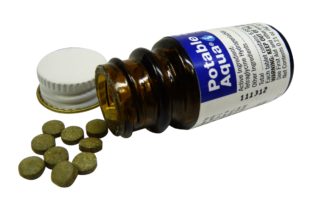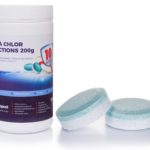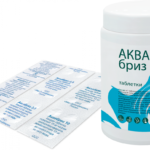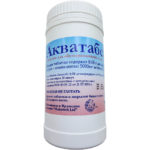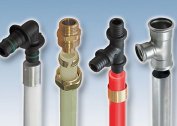The critical state of the environmental situation poses a danger to modern man, especially if the question is about the quality of drinking water, which is taken directly from natural open / closed sources. To bring it into a usable state, special tablets are used to purify water. The level of biological hazard from the treated fluid is reduced significantly.
Purpose, scope of disinfecting tablets
The main objective of the preparations is to remove bacteria, viruses, and other biological contaminants from the aquatic environment. Basically, the funds are divided into several types:
- iodine-containing;
- chlorine-containing;
- preparations based on silver ions.
Chlorine tablets are recognized as the fastest and most effective.
The use of disinfecting drugs is relevant in the following cases:
- Long hikes and the need to use drinking water from natural sources (rivers, lakes, streams). The quality of such a resource is highly doubtful.
- The presence of wells in the country, having low productivity with insufficient operation (seasonally). Stagnant water is an excellent medium for the reproduction of bacteria.
- Villages located near military training grounds. Often various tests are carried out at such bases, which strongly pollute the water reservoirs of the region. As a result, a resource from local wells, wells of not the best quality.
- Dead animals caught in the source (birds, rodents, frogs, etc.). The body of the dead individual poisons the water with cadaveric poisons, so the liquid requires a mandatory disinfectant treatment.
The main requirements for the drugs used are good disinfection, high speed, and complete absence of sediment.
Types of tablets and the principle of their action
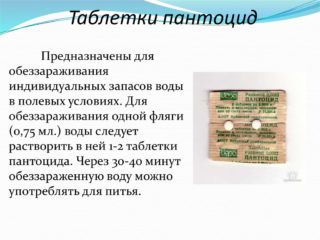 The main principle of drug action is dissolution in water and further binding (cleavage / destruction) of all toxic impurities. The only side effect is the presence of sediment in the treated liquid. It must be removed by filtration through cheesecloth, careful overflow or the use of activated carbon.
The main principle of drug action is dissolution in water and further binding (cleavage / destruction) of all toxic impurities. The only side effect is the presence of sediment in the treated liquid. It must be removed by filtration through cheesecloth, careful overflow or the use of activated carbon.
The most popular are these types of tablets for disinfecting drinking water:
- Pantocide. Its main active ingredient is halazone. When acting in water, the drug does not give a tangible taste, color, smell. You can use pills to treat wounds. The average cost of the product is 150 rubles. The drug is sold in blisters / packs of 40 pieces in one.
- Aquabriz. Domestic chlorine based product. It is highly popular due to its effectiveness and reasonable cost. The price for 10 tablets is about 30 rubles.
- Aquatabs. The drug is made in Ireland. The main active ingredient is chlorine. It is believed that after the treatment of water with this drug, it is prohibited to store it for a long time. The price of packing tablets is about 2,000 rubles.
- Aqua Chlorine. Another remedy from the group of chlorine-containing. Manufacturer - Russia. 400 tablets in a pack. The average price of a drug is 400 rubles. Aqua-chlorine is guaranteed to act on all types of bacteria.
- Potable Aqua. The drug is made in the USA based on iodine. It has established itself as an effective tool for hiking. Sold in polymer bottles of 50 pcs. The average price of 700 rubles.
The most popular means for disinfecting the walls of wells and the water in them are Ecobriz-Oxy and Septolit-DHTs. The tablets must be diluted in the recommended amount of clean water and treated with a solution of the mine ring.After 30 minutes, you can wash off the product, pump out the water and put the disinfected source into operation.
Features of the use of drugs
Despite the fact that the tablets are easy to use, there are important features that should be considered when processing liquids:
- Before and after disinfection, it is advisable to filter the water. In the first case, this will help remove large visible debris. In the second - remove the sediment.
- It is necessary to withstand the recommended time in the instructions when processing a liquid medium. Usually it is 15-30 minutes. All components of the tablets should fully complete their action.
- It is necessary to strictly observe the proportions of the drug per dose of liquid.
- After disinfection, it is advisable to boil water additionally. Drinking it raw is not recommended.
- Use chemical means for disinfecting drinking water is necessary in extreme cases, if other methods of cleaning the liquid are not available.
- If children go camping, it is best to support their body with probiotics. Chemicals can disrupt the digestive tract of a small tourist.
Do not use expired drugs. At least the effect of them will be zero. In the worst case, a deplorable result is possible - toxic poisoning.
Advantages and disadvantages of the method
The increased demand for tablets for the treatment of drinking water is formed due to these advantages:
- The drug weighs little, is light on the hike, does not take up much space in the backpack. There is no need to carry heavy cans of drinking water in the field.
- Short deadlines for disinfection. After 15 minutes, the water is ready for further use.
- The ability to disinfect fluid from any natural source.
- When using tablets, there is no need to apply additional methods of processing the resource.
- Lack of pungent taste and smell of water during its processing by tablets.
The drugs have a number of minuses:
- Inability to use for allergy sufferers. Chlorine, iodine, or silver can trigger unexpected reactions from a weak body.
- Difficulty in cleaning water with a lot of pollution.
- Preparations based on chlorine, iodine are considered conditionally toxic to the human body. Therefore, their frequent use is undesirable.
If tablets are used to treat well or well water, it is advisable to do a preliminary detailed analysis. Perhaps the composition of the liquid medium is rich in other impurities, which chlorine-containing tablets will not cope with.
